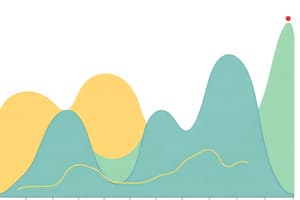Podcast
Questions and Answers
What is the first step in creating a line plot?
What is the first step in creating a line plot?
- Analyze the data for patterns and outliers
- Identify the categories of data (correct)
- Determine the scale of the graph
- Place a dot over each number in the data set
What does the scale of a line plot refer to?
What does the scale of a line plot refer to?
- The range of values represented on the number line
- The interval between each tick mark on the number line (correct)
- The number of categories being plotted on the line
- The frequency of each category on the number line
How can outliers be identified in a line plot?
How can outliers be identified in a line plot?
- By looking for dots that are far away from the others on the number line (correct)
- By identifying the category with the most instances on the number line
- By analyzing the patterns in the distribution of dots on the number line
- By comparing the frequency of each category on the number line
What can be inferred about a category if it has more dots towards the end of the line plot?
What can be inferred about a category if it has more dots towards the end of the line plot?
Which of the following is NOT a key purpose of creating a line plot?
Which of the following is NOT a key purpose of creating a line plot?
How can the frequency of different categories be compared in a line plot?
How can the frequency of different categories be compared in a line plot?
What is the name of the protagonist in the novel?
What is the name of the protagonist in the novel?
What is the central theme of the novel 'The Number the Stars'?
What is the central theme of the novel 'The Number the Stars'?
Which character in the novel risks their own safety to ensure the success of the operation to bring a Jewish boy to Sweden?
Which character in the novel risks their own safety to ensure the success of the operation to bring a Jewish boy to Sweden?
Which character in the novel embodies bravery through their determination to care for their family despite the dangers posed by the war?
Which character in the novel embodies bravery through their determination to care for their family despite the dangers posed by the war?
What is the role of Annemarie's best friend Ellen in the narrative of 'The Number the Stars'?
What is the role of Annemarie's best friend Ellen in the narrative of 'The Number the Stars'?
What is the setting of 'The Number the Stars'?
What is the setting of 'The Number the Stars'?
Flashcards are hidden until you start studying
Study Notes
Creating Line Plots
Creating a line plot involves organizing data in a visual format that makes it easy to analyze and interpret. Here are the general steps to create a line plot:
- Identify the categories of data. These are the labels that will appear on the number line.
- Determine the scale of the graph. This is the interval between each tick mark on the number line.
- Place a dot over each number in the data set. If a number appears multiple times, place additional dots over the same position.
Analyzing Data with Line Plots
Line plots are particularly useful for identifying patterns and outliers in data. Outliers are extreme values that significantly deviate from the rest of the data. They can be identified by looking for dots that are far away from the others on the number line. Additionally, comparing the location of dots on the number line allows you to compare the frequency of each category.
Interpreting Trends from Line Plots
Interpreting trends from line plots involves looking for patterns in the distribution of dots on the number line. For example, if one category has more dots near the end of the line, this indicates that there are more instances of that category in the higher ranges. Conversely, if another category has fewer dots towards the end of the line, this suggests that there are fewer instances of that category in the higher ranges.
Remember, the goal when creating a line plot is to simplify and visualize complex data. To achieve this, ensure that the number line accurately reflects the scale of the data and the dots are placed correctly according to the frequency of occurrence of each category.
Studying That Suits You
Use AI to generate personalized quizzes and flashcards to suit your learning preferences.




